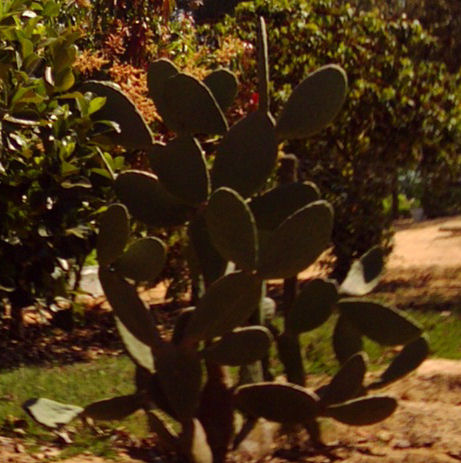

Opuntia ficus-indica (Fig Cactus)
Opuntia ficus-indica is a species of species-rich genus of the genus Opuntia of the family Cactaceae, probably comes from Mexico. Due to the long cultivation of the species, the original distribution is not know. The species is wild in South America, Australia and the Mediterrean area. Molecular genetic studies suggest that Opuntia ficus-indica is a domesticated form of Opuntia megacantha.
Opuntia ficus-indica grows shrubby or treelike and reachs growth heights between 3 to 20 feet. Usually there is a distinct trunk of up to about 1 foot. The different formed green shoot parts are narrow to broadly obovate or oblong. They are 2/3 to 2 feet long and 4 to 10 inches wide. The slim elliptical areoles are 0.8 to 2 inches apart. They are filled with brown or yellow glochides, which fall off soon. The spines are inconspicuous and often absent. Nevertheless the glochides are notorious for their difficult removability from human skin, you need tweezers and magnifying glasses, they cause itching and inflammation. Therefore you should only touch the shoots with thick leather gloves when working with the cactus you have to be very careful and avoid touching the clothes with the cactus.
The flowers are terinally on shoots, are yellow to red and have a diameter of 2 to 4 inches. The ovoid to oblong, green, orange or red fruits are 2.4 to 4 inches long. They are equipped with glochides and sometimes studded with thorns.
The interior of the fruit is eaten with the equally edible seeds. That, depending on variety, yellow, orange to red pulp has a sweet-sour taste. The fruit should be kept only with a fork because of the spikes and the skin should be removed by one knife carefully. Or, you hold the fruit with a thick plastic sheet in hand, cut it by a knife and spoon the interior out by one teaspoon. Take the fruits at first for some time into cold water, the thorns will become softer and you can remove them by one brush. The fruit can be eaten in-natura, as jam or drinken as liqueur Bajtra.
In your garden we have one larger specimen and one smaller.

Opuntia ficus-indica in our garden in September 2008.
Back to the Agricultural Plant List
Created by Joachim Jaeck on December 1st, 2009